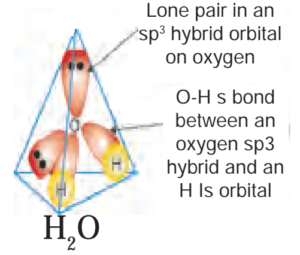(1) Select and write the most appropriate alternatives from the given choices.
(A) Which molecule is linear?
(a) SO3
(b) CO2
(c) H2S
(d) Cl2O
(B) When the following bond types are listed in decreasing order of strength (strongest first). Which is the correct order ?
(a) covalent > hydrogen > vander waal’s
(b) covalent > vander waal’s > hydrogen
(c) hydrogen > covalent > vander waal’s
(d) vander waal’s > hydrogen > covalent.
(C) Valence Shell Electron Pair repulsion (VSEPR) theory is used to predict which of the following :
(a) Energy levels in an atom
(b) the shapes of molecules and ions.
(c) the electron negetivities of elements.
(d) the type of bonding in compounds.
(D) Which of the following is true for CO2?
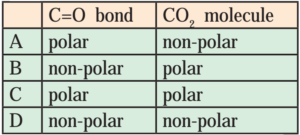
Ans : (a)
(E) Which O2 molecule is pargmagnetic. It is explained on the basis of :
(a) Hybridisation
(b) VBT
(c) MOT
(d) VSEPR
(F) The angle between two covalent bonds is minimum in:
(a)CH4
(b) C2H2
(c) NH3
(d) H2O
(2) Draw
(A) Lewis dot diagrams for the following
(a) Hydrogen (H2)
Ans : ![]()
(b) Water (H2O)
Ans : ![]()
(c) Carbon dioxide (CO2)
Ans :![]()
(d) Methane (CH2)
Ans : 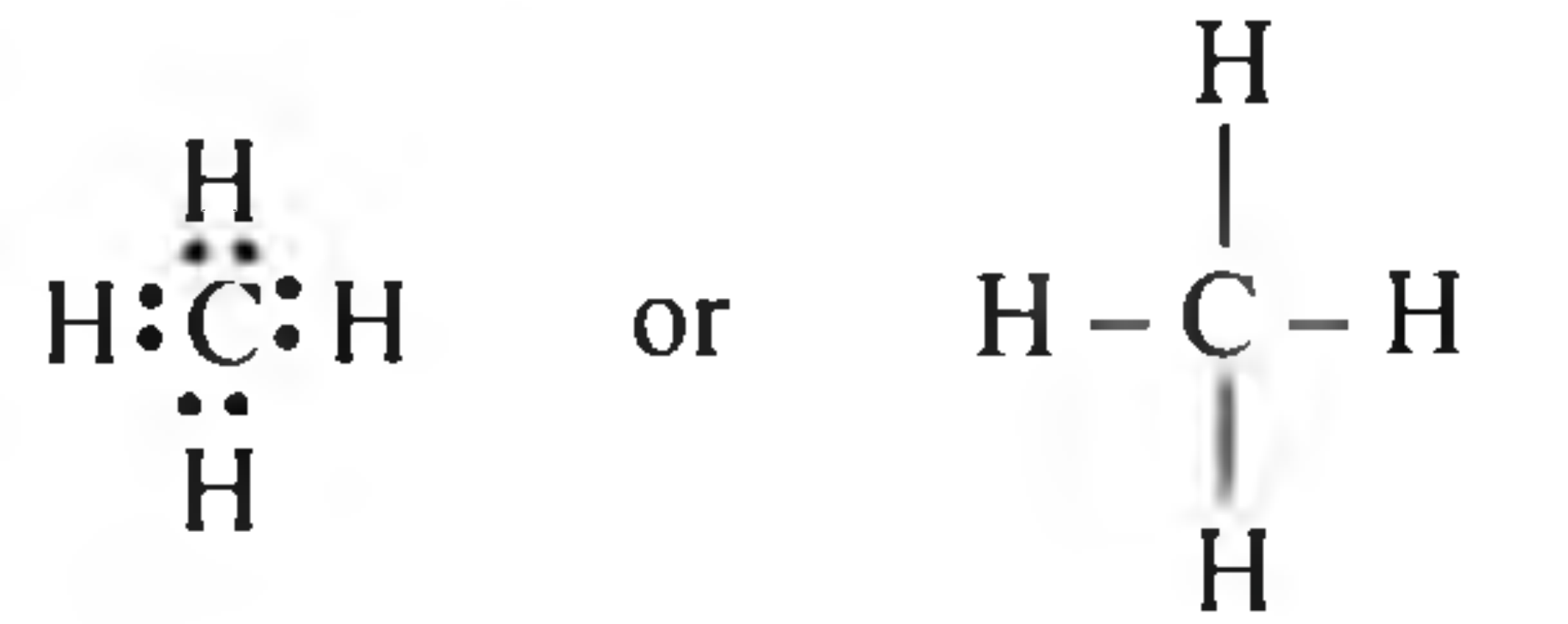
(e) Lithium Fluoride (LiF)
Ans : ![]()
(B) Diagram for bonding in ethene with sp2 Hybridisation.
Ans : 
(C) Lewis electron dot structures of
(a) HF
Ans : 
(b) C2H6
Ans : 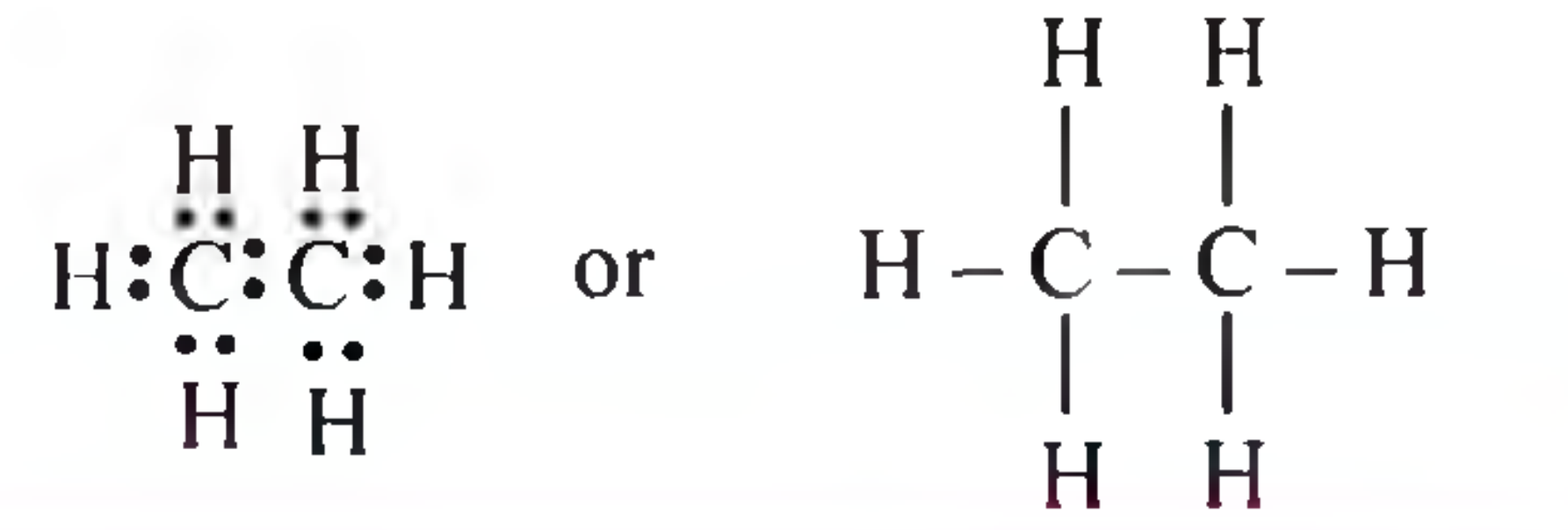
(c) C2H4
Ans : 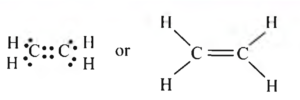
(d) CF3Cl
Ans : 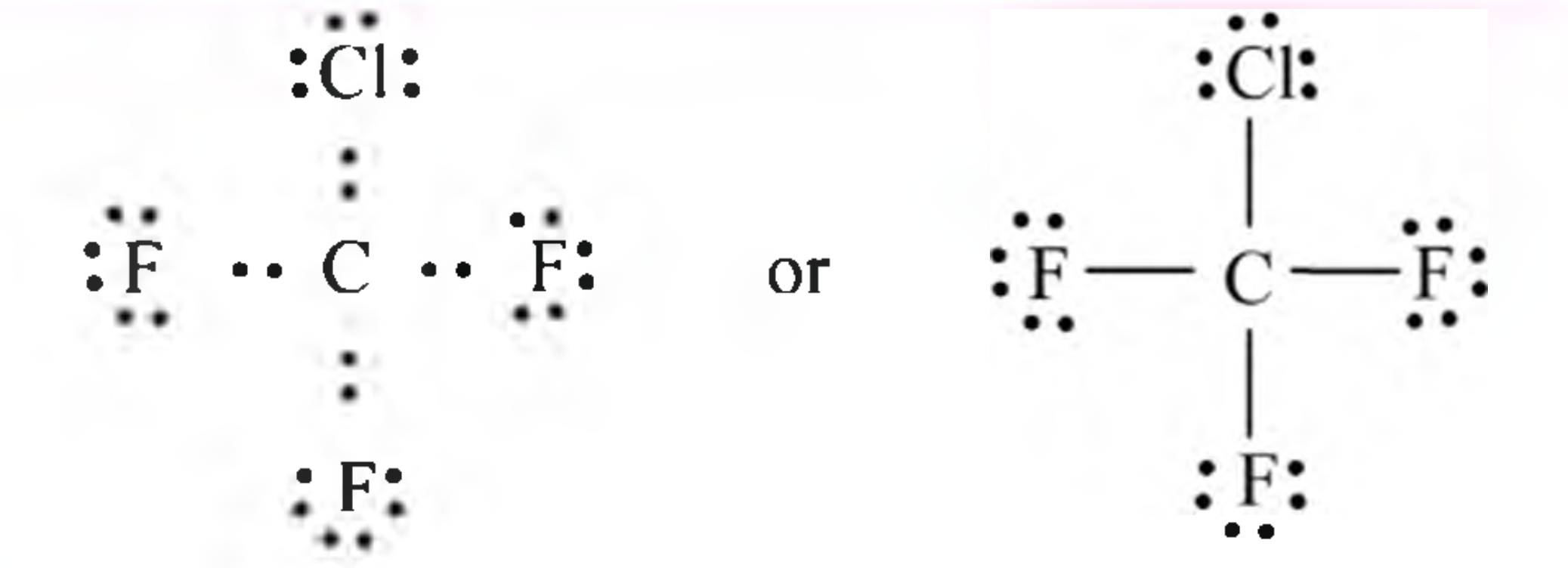
(e) SO2
Ans : 
(D) Draw orbital diagrams of
(a) Fluorine molecule
Ans : 
(b) Hydrogen fluoxide molecule
Ans : 
(3) Answer the following questions
(A) Distinguish between sigma and pi bond.
Ans : 
(B) Display electron distribution around the oxygen atom in water molecule and state shape of the molecule, also write H-O-H bond angle.
Ans: Electron distribution around oxygen atom in water molecule:
Shape of water molecule: Angular or V shaped H-O-H bond angle = 104°35′
(C) State octal rule. Explain its inadequecies with respect to
a. Incomplete octal b. Expanded octal
Statement: During the formation of chemical bond, atom loses, gains or shares electrons so that its
outermost orbit (valence shell) contains eight electrons. Therefore, the atom attains the nearest inert gas electronic configuration.
(D) Explain in brief with one example:
(i) Ionic bond (ii) covalent bond (iii) co-ordinate bond
Ans : (i) Ionic bond – The bond formed by complete transfer of one or more electrons from an electropositive atom to an electronegative atom, leading to formation of ions which are held together by electrostatic attraction is called ionic bond or electrovalent bond.
Formation of sodium chloride (NaCl):
(a) The electronic configurations of sodium and chlorine are:
Na (Z = 11): 1s2 2s2 2p6 3s1 or (2, 8, 1)
Cl (Z = 17): 1s2 2s2 2p6 3s2 3p5 or (2, 8, 7)
(b) Sodium has one electron in its valence shell. It has tendency to lose one electron to acquire the electronic configuration of the nearest inert gas, neon (2, 8).
(c) Chlorine has seven electrons in its valence shell. It has tendency to gain one electron and thereby acquire the electronic configuration of the nearest inert gas, argon (2, 8, 8).
(d) During the combination of sodium and chlorine atoms, the sodium atom transfers its valence electron to the chlorine atom.
(e) Sodium atom changes into Na+ ion while the chlorine atom changes into Cl– ion. The two ions are held
together by strong electrostatic force of attraction.
(f) The formation of ionic bond between Na and Cl can be shown as follows:
(ii) covalent bond : The attractive force which exists due to the mutual sharing of electrons between the two atoms of similar
electronegativity or having small difference in electronegativities is called a covalent bond.
Formation of H2 molecule:
(a) The electronic configuration of H atom is 1s1.
(b) It needs one more electron to complete its valence shell.
(c) When two hydrogen atoms approach each other at a certain intemuclear distance, they share their valence electrons.
(d) The shared pair of electrons belongs equally to both the hydrogen atoms. The two atoms are said to be linked by a single covalent bond and a H2 molecule is formed.

Formation of Cl2 molecule:
(a) The electronic configuration of Cl atom is [Ne] 3s2 3p5
(b) It needs one more electron to complete its valence shell.
(c) When two chlorine atoms approach each other at a certain internuclear distance, they share their valence electrons. In the process, both the atoms attain the valence shell of octet of nearest noble gas, argon.
(d ) The shared pair of electrons belongs equally to both the chlorine atoms. The two atoms are said to be linked by a single covalent bond and a Cl2 molecule is formed.
![]()
(iii) co-ordinate bond :
(a) A coordinate bond is a type of covalent bond where both of the electrons that form the bond originate from same atom.
(b) An atom with a lone pair of electrons (non-bonding pair of electrons) is capable of forming a coordinate bond.
(c). For example, reaction of ammonia with boron trifluoride: Before the reaction, nitrogen (N) in ammonia has eight valence electrons, including a lone pair of electrons. Boron (B) in boron trifluoride has only six valence electrons, so it is two electrons short of an octet. The two unpaired electrons form a bond between nitrogen and boron, resulting in complete octets for both atoms. A coordinate bond is represented by an arrow. The direction of the arrow indicates that the electrons are moving from nitrogen to boron. Thus, ammonia forms a coordinate bond with boron trifluoride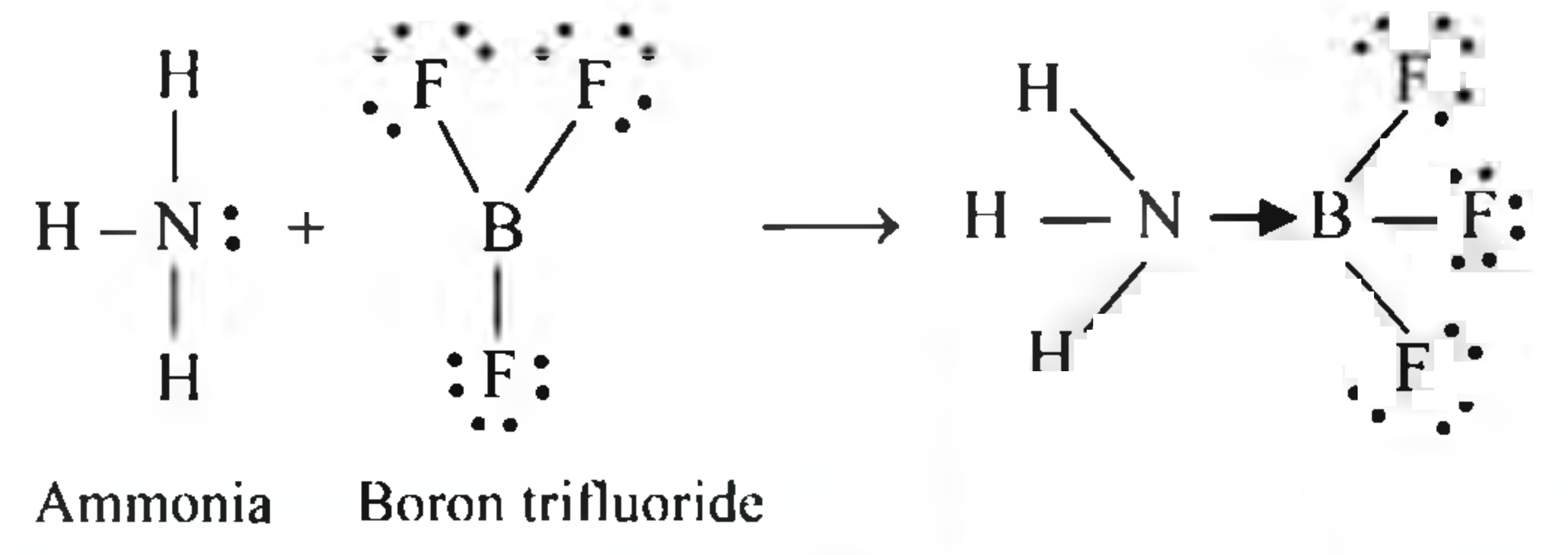
(d) Once formed, a coordinate covalent bond is the same as any other covalent bond.
(E) Give reasons for need of Hybridisation.
Ans: The concept of hybridization was introduced because the valence bond theory failed to explain the following :
points:
(i) Valencies of certain elements:
The maximum number of covalent bonds which an atom can form equals the number of unpaired electrons present in its valence shell. However, valence bond theory failed to explain how beryllium, boron and carbon forms two, three and four covalent bonds respectively.
(a) Beryllium: The electronic configuration of beryllium is 1s2 2s2. The expected valency is zero (as there is no unpaired electron) but the observed valency is 2 as in BeCl2.
(b) Boron: The electronic configuration of boron is 1s2 2s2 2p1x . The valency is expected to be 1 but it is 3 as in BF3.
(c) Carbon: The electronic configuration of carbon is 1s2 2s2 2p1x 2p1y . The valency is expected to be 2, but observed valency is 4 as in CH4.
(ii) The shapes and geometry of certain molecules:
The valence bond theory cannot explain shapes, geometries and bond angles in certain molecules,
e.g. (a) Tetrahedral shape of methane molecule.
(b) Bond angles in molecules like NH3 (107° 18′) and H2O (104°35′). However, the valency of the above elements and the observe structural properties of the above molecules can be explained by the concept of hybridization. These are the reasons for need of the concept of hybridization.
(F) Explain geometry of methane molecule on the basis of Hybridisation.
Ans: Formation of methane (CH4) molecule on the basis of sp3 hybridization:
(a) Methane molecule (CH4) has one carbon atom and four hydrogen atoms.
(b) The ground state electronic configuration of C (Z = 6) is 1s2 2s2 2p1x 2p1y, 2P0z
Electronic configuration of carbon: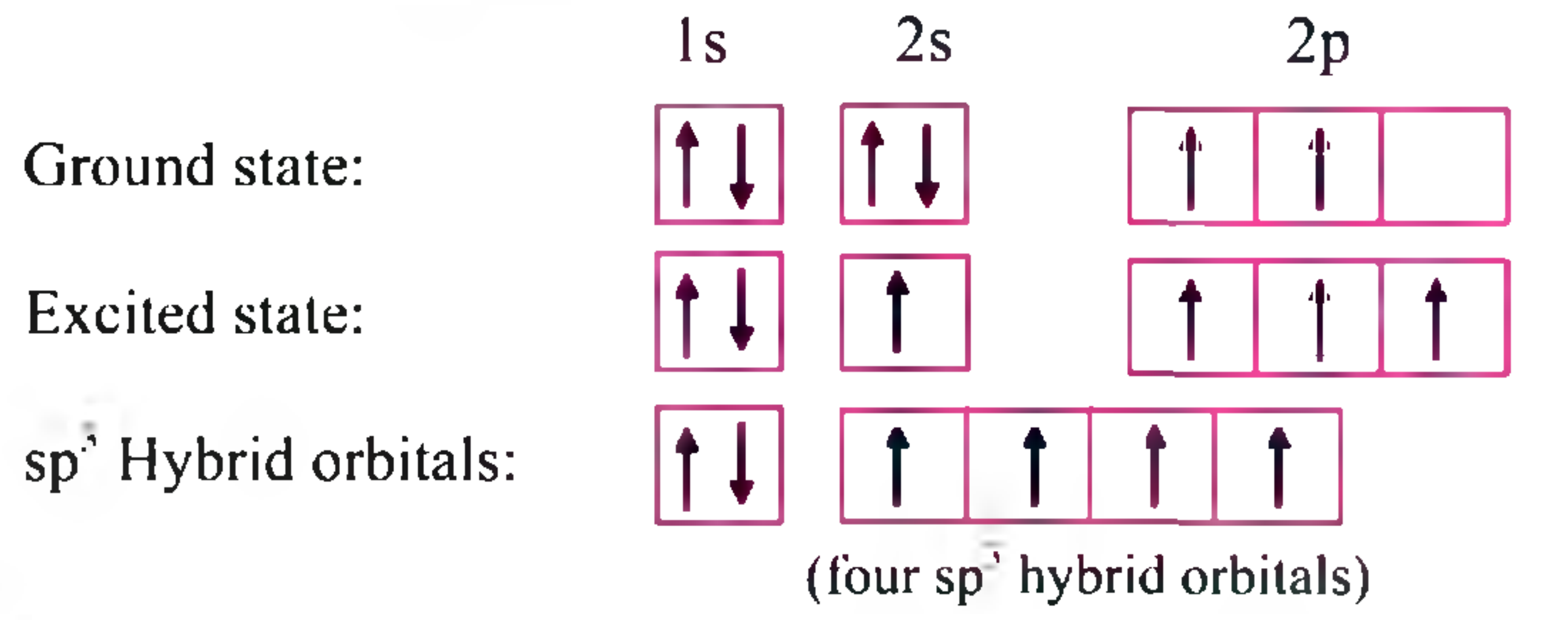
(c) In order to form four equivalent bonds with hydrogen, the 2s and 2p orbitals of C-atom undergo sp3 hybridization.
(d) One electron from the 2s orbital of carbon atom is excited to the 2pz orbital. Then the four orbitals 2s, px, py and pz mix and recast to form four new sp1 hybrid orbitals having same shape and equal energy. They are maximum apart and have tetrahedral geometry with H-C-H bond angle of 109°28′. Each hybrid orbital contains one unpaired electron.
(e) Each of these sp1 hybrid orbitals with one electron overlap axially with the 1s orbital of hydrogen atom to form one C-H sigma bond. Thus, in CH4 molecule, there are four C-H bonds formed by the sp -s overlap.
Diagram:
(G) In Ammonia molecule the bond angle is 1070 and in water molecule it is 104035/, although in both the central atoms are sp3 hybridized Explain.
Ans:
(i) The ammonia molecule has sp3 hybridization. The expected bond angle is 109°28′. But the actual bond angle is 107°28′. It is due to the following reasons.
(a) One lone pair and three bond pairs are present in ammonia molecule.
(b) The strength of lone pair – bond pair repulsion is much higher than that of bond pair-bond pair repulsion.
(c) Due to these repulsions, there is a small decrease in bond angle (~2°) from 109°28′ to 107° 18′.
(ii) The water molecule has sp3 hybridization. The expected bond angle is 109°28′. But the actual bond angle is 104°35′. It is due to the following reasons.
(a) Two lone pairs and two bond pairs are present in water molecule.
(b) The decreasing order of the repulsion is Lone pair-Lone pair > Lone pair-Bond pair > Bond pair-Bond pair.
(c) Due to these repulsions, there is a small decrease in bond angle (~5°) from 109°28′ to 104°35′.
(H) Give reasons for:
(i) Sigma (σ)bond is stronger than Pi (π)bond.
(ii) HF is a polar molecule
(iii) Carbon is a tetravalent in nature.
Ans:
(i) Sigma (σ)bond is stronger than Pi (π)bond:
(a)The strength of the bond depends on the extent of overlap of the orbitals. Greater the overlap, stronger is the bond.
(b)A sigma bond is formed by the coaxial overlap of the atomic orbitals which are oriented along the internuclear axis, hence the extent of overlap is maximum.
(c)A pi bond is formed by the lateral overlap of the atomic orbitals which are oriented perpendicular to the internuclear axis, hence the extent of orbital overlapping in side wise manner is less. Hence, sigma bond is stronger than pi bond.
(ii) HF is a polar molecule
i. When a covalent bond is formed between two atoms of different elements that have different electronegativities, the shared electron pair does not remain at the centre. The electron pair is pulled towards the more electronegative atom resulting in the separation of charges.
ii. In H-F, fluorine is more electronegative than hydrogen. Therefore, the shared electron pair is pulled towards fluorine and fluorine acquires partial -ve charge and simultaneously hydrogen acquires partial +ve charge. This gives rise to dipole and H-F bond becomes polar. Hence, H-F is a polar molecule.
(iii) Carbon is a tetravalent in nature:
The electronic configuration of carbon is: 1s2 2s2 2p1x 2p1y One electron from ‘2s’ orbital is promoted to the empty ‘2p’ orbital. Thus, in excited state, carbon has four half-filled orbitals.
Hence, carbon can form 4 bonds and is tetravalent in nature.
(I) Which type of hybridization is present in ammonia molecule? Write the geometry and bond angle present in ammonia.
Ans: The type of hybridization present in ammonia (NH3) molecule is sp3.
Geometry of ammonia molecule is pyramidal or distorted tetrahedral.
Bond angle in ammonia molecule is 107° 18′.
(J) Identify the type of orbital overlap present in
(a) H2 (b) F2 (c) H-F molecule
Explain diagrammatically.
Ans : (a)s-s a overlap:
The overlap between two half-filled s orbitals of two different atoms containing unpaired electrons with opposite spins is called s-s overlap,
e.g. Formation of H2 molecule by s-s overlap:
Hydrogen atom (Z = 1) has electronic configuration: 1s1. The 1s1 orbitals of two hydrogen atoms overlap along the internuclear axis to form a a bond between the atoms in H2 molecule.(b) p-p a overlap:
This type of overlap takes place when two p orbitals from different atoms overlap along the internuclear axis.
e.g. Formation of F2 molecule by p-p overlap:
Fluorine atom (Z = 9) has electronic configuration 1s2 2s2 2p2 2p2 2p1. During the formation of F2 molecule, half-filled 2pz orbital of one F atom overlaps with similar half-filled
2pzorbital containing electron with opposite spin of another F atom axially and a p-p a bond is formed.
(c) s-p a overlap:
In this type of overlap one half filled s orbital of one atom and one half filled p orbital of another orbital overlap along the internuclear axis,
e.g. Formation of HF molecule by s-p overlap:
Hydrogen atom (Z = 1) has electronic configuration: 1s1 and fluorine atom (Z = 9) has electronic configuration 1s2 2s2 2p2 2p3 2p1. During the formation of HF molecule, half-filled Is orbital of hydrogen atom overlaps coaxially with half-filled 2pz orbital of fluorine atom with opposite electron spin and an s-p a bond is formed.
(K) F-Be-F is a liner molecule but H-O-H is angular. Explain.
Ans:
(a) In the BcF2 molecule, the central beryllium atom undergoes sp3 hybridization giving rise to two sp3 hybridized orbitals placed diagonally opposite with an angle of 180°. Thus, F-Be-F is a linear molecule.
(b) In the H2O molecule, the central oxygen atom undergoes sp1 hybridization giving rise to four sp3 hybridized orbitals directed towards four corners of a tetrahedron. There are two lone pairs of electrons in two of the sp3 hybrid orbitals of oxygen. The lone pair-lone pair repulsion distorts the structure. Henee, H-O-H is angular or V-shaped.
(L) BF3 molecule is planar but NH3 pyramidal. Explain.
Ans:
(a) In the BF3 molecule, the central boron atom undergoes sp2 hybridization giving rise to three sp2 hybridized orbitals directed towards three corners of an equilateral triangle. Thus, the geometry is trigonal planar.
(b) In the NH3 molecule, the central nitrogen atom undergoes sp1 hybridization giving rise to four sp3 hybridized orbitals directed towards four corners of a tetrahedron. The expected geometry of NH3 molecule is regulartetrahedral with bond angle 109°28′ There is one lone pair of electrons in one of the sp3 hybrid orbitals of nitrogen. The lone pair-bond pair repulsion distorts the bond angle. Hence, the structure of NH3 is distorted and it has pyramidal geometry.
(M) In case of bond formation in Acetylenemolecule :
(a) How many covalend bonds are formed ?
(b) State number of sigma and pi bonds formed.
(c) Name the type of Hybridisation.
Ans:
(a) In acetylene molecule, there are five covalent bonds.
(b) In acetylene molecule, there are three sigma bonds and two pi bonds.
(c) In acetylene molecule, each carbon atom undergoes sp hybridization.
(N) Define : a. Bond Enthalpy b. Bond Length
Ans: (a) Bond enthalpy is defined as the amount o f energy required to break one mole o f bond o f one type, present between two atoms in a gaseous state.
(b) Bond length is defined as the equilibrium distance between the nuclei o f two covalently bonded atoms in amolecule.a
(O) Predict the shape and bond angles in the following molecules:
a. CF4 b. NF3
c. HCN d. H2S
Ans :
(a) CF4: There arc four bond pairs on the central atom. Hence, shape of CF4 is tetrahedral and F-C-F bond angle is 109° 28′.
(b) NF3: There are three bond pairs and one lone pair on the central atom. Hence, shape of NF3 is trigonal pyramidal and F-N -F bond angle is less than 109° 28′.
(c) HCN: There are two bond pairs on the central atom. Hence, shape of HCN is linear and H-C-N bond angle is 180°.
(d) H2S: There are two bond pairs and two lone pairs on the central atom. Hence, shape of H2S is bent or V-shaped and H-S-H bond angle is slightly less than 109° 28′.
(4) Using data from the Table, answer the following :
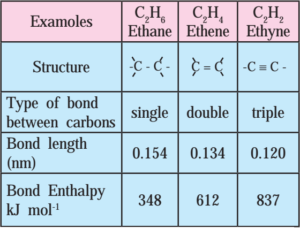
(a) What happens to the bond length when unsaturation increases?
(b) Which is the most stable compound?
(c) Indicate the relation between bond strength and Bond enthalpy.
(d) Comment on overall relation between Bond length, Bond Enthalpy and Bond strength and stability
Ans:
(a) When unsaturation increases, the bond length decreases.
(b) The stable compound is ethyne (C2H2).
(c). Bond strength α Bond enthalpy Larger the bond enthalpy, stronger is the bond.
(d) As bond length decreases, bond enthalpy, bond strength and stability increase.
(5) Complete the flow chart
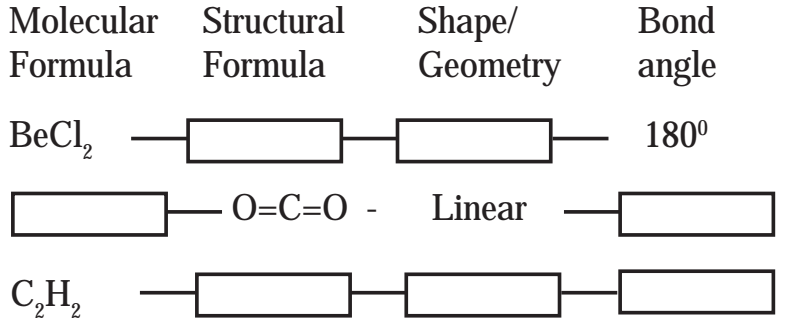
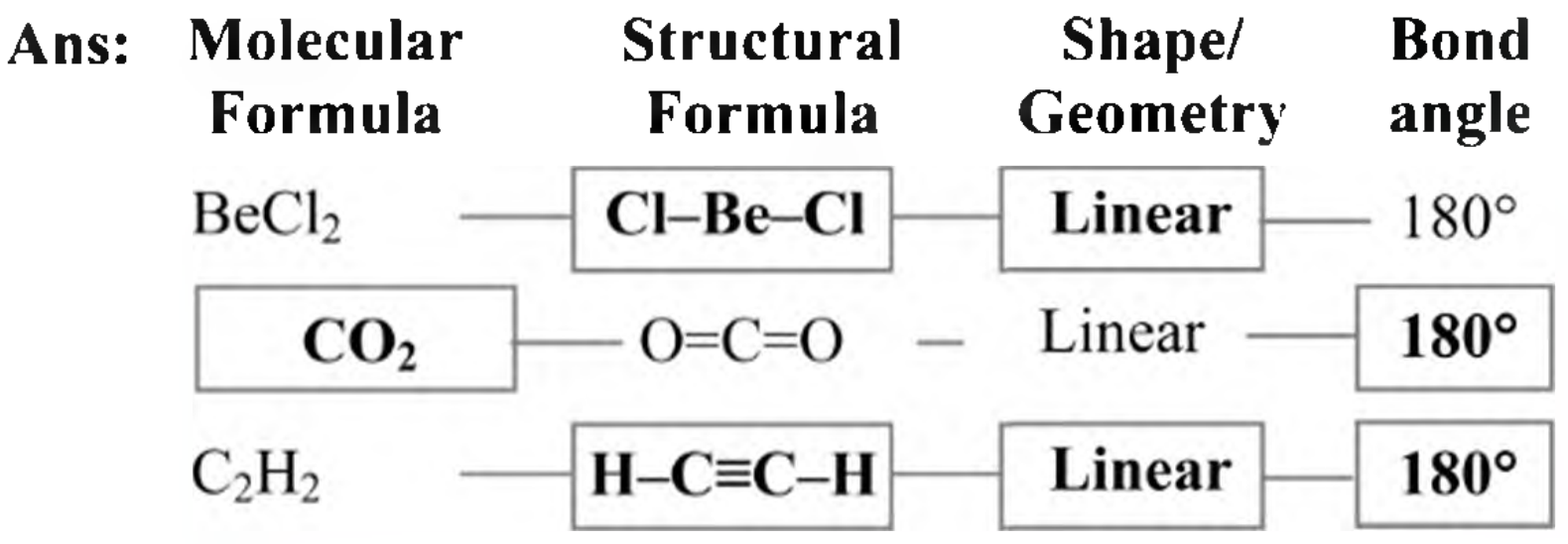
(6) Complete the following Table
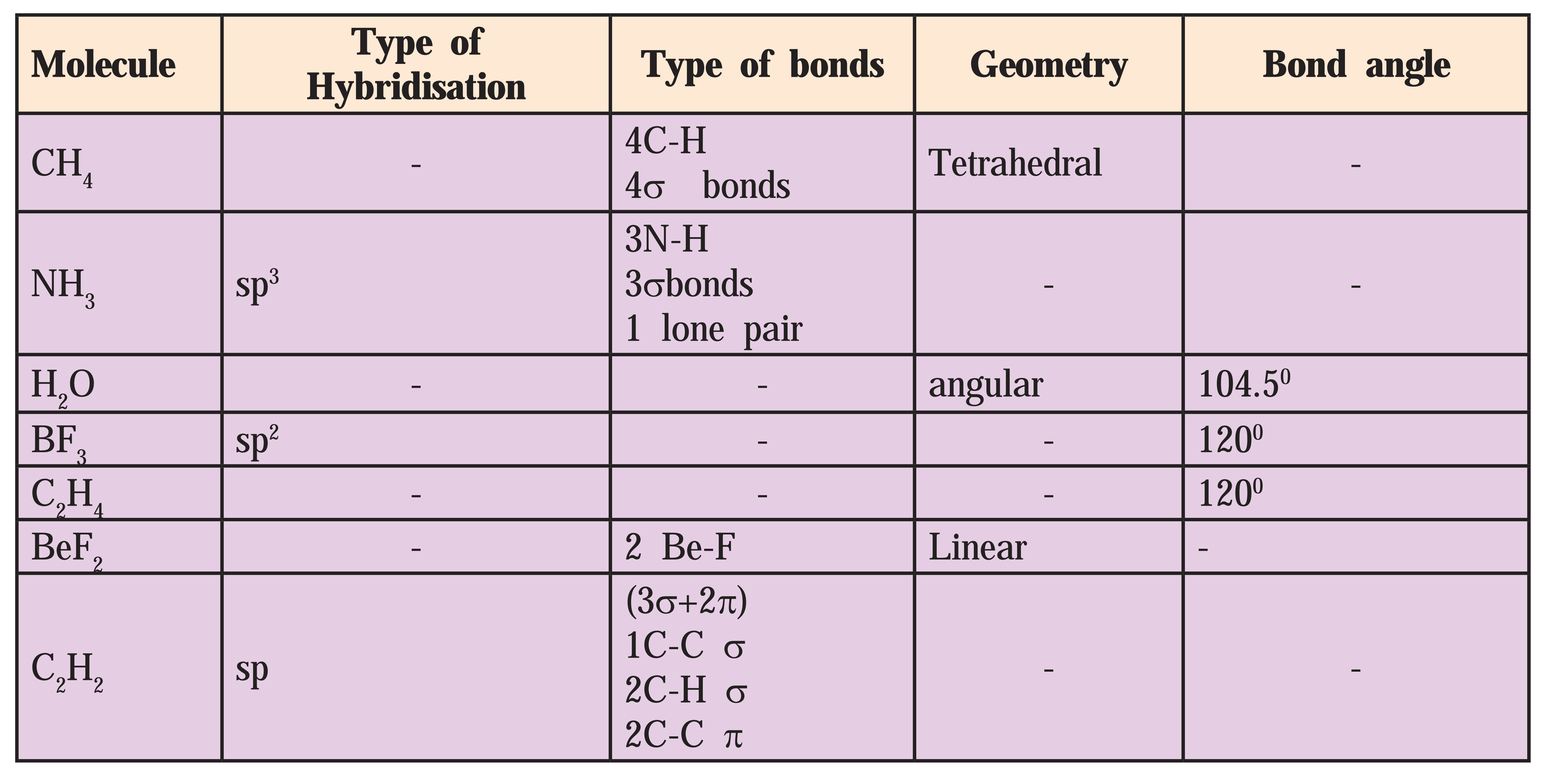
Ans :
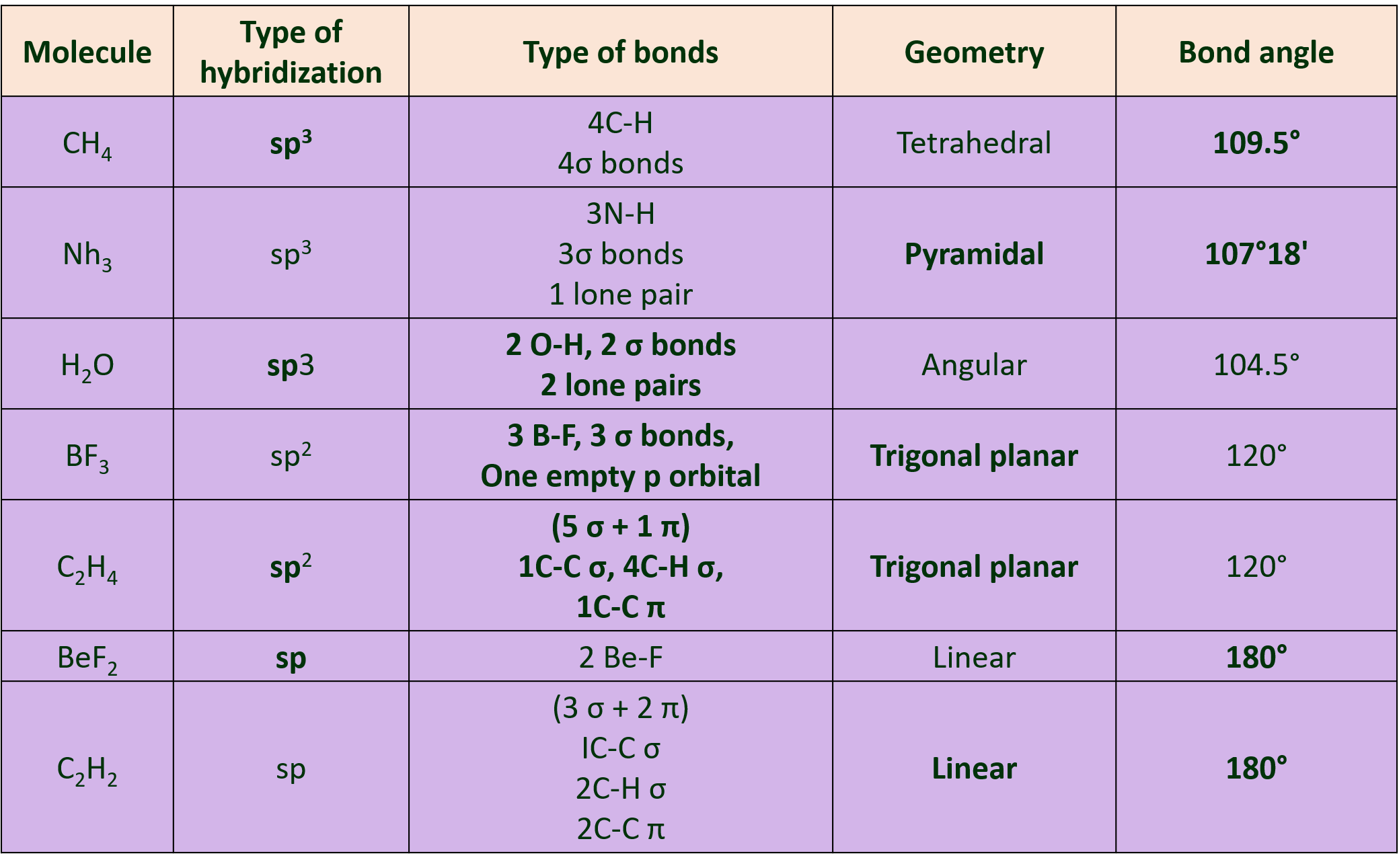
(7) Answer in one sentence:
(A) Indicate the factor on which stalility of ionic compound is measured?
Ans : The stability of an ionic compound is measured by the amount of energy released during lattice formation.
(B) Arrange the following compounds on the basis of lattice energies in decreasing (descending) order: BeF2 , AlCl3, LiCl, CaCl2, NaCl
Ans : AICI3 > BeF2 > CaCl2 > LiCl > NaCl
(C) Give the total number of electrons around sulphur (S) in SF6 compound.
Ans: The total number of electrons around sulphur (S) in SF6 is 12.
(D) Covalant bond is directional in nature. Justify.
Ans : Covalent bond is formed by the overlap of two half-filled atomic orbitals. The atomic orbitals are oriented in specific directions in space (except s-orbital which is spherical). Hence, covalent bond is directional in nature.
(E) What are the interacting forces present during formation of a molecule of a compound ?
Ans : When two combining atoms approach each other to form a covalent bond, the following interacting forces come into play.
(a) Forces of attraction: The nucleus of one atom attracts the electrons of the other atom and vice-versa.
(b) Forces of repulsion: The electron of one atom repels the electron of the other atom and vice-versa (as electrons are negatively charged). There is repulsion between the two nuclei (as the nuclei are positively charged).
(F) Give the type of overlap by which pi (π) bond is formed.
Ans: The type of overlap by which pi (π) bond is formed is p-p lateral overlap.
(). Mention the steps involved in Hybridization.
Ans: The steps involved in hybridization are:
(i) formation of the excited state and (ii) mixing and recasting of orbitals.
(H) Write the formula to calculate bond order of molecule.
Ans: Bond order of a molecule = ![]()
where, N(, is the number of electrons present in bonding MOs and Na is the number of electrons present in antibonding MOs.
(I) Why is O2 molecule paramagnetic?
Ans: The electronic configuration of O2 molecule is
(σ1s)2 (σ*1s)2 (σ2s)2 (σ*2s)2 σ2pz)2 (π2px)2 (π2py)2 (π*2px)1 (π*2py)1
Since oxygen molecule contains two unpaired electrons, it is paramagnetic.
(J) What do you mean by formal charge ? Explain its significance with the help of suitable example.
Ans : Formal charge is the charge assigned to an atom in a molecule, assuming that all electrons are shared equally between atoms, regardless of their relative electronegativities.

Formal charges on atoms calculated as shown below

